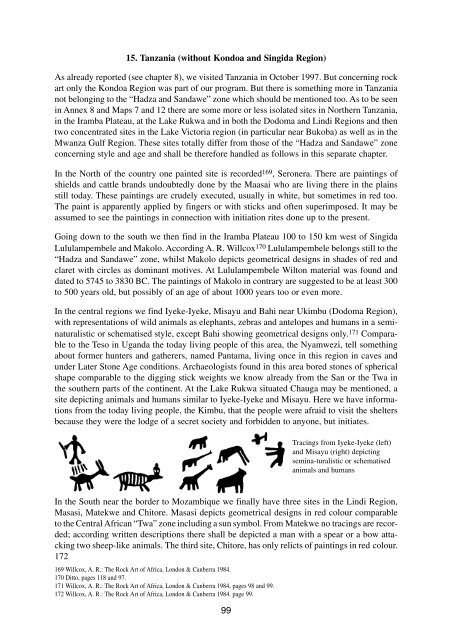1.) schw.weiss - StoneWatch
1.) schw.weiss - StoneWatch
1.) schw.weiss - StoneWatch
You also want an ePaper? Increase the reach of your titles
YUMPU automatically turns print PDFs into web optimized ePapers that Google loves.
15. Tanzania (without Kondoa and Singida Region)<br />
As already reported (see chapter 8), we visited Tanzania in October 1997. But concerning rock<br />
art only the Kondoa Region was part of our program. But there is something more in Tanzania<br />
not belonging to the “Hadza and Sandawe” zone which should be mentioned too. As to be seen<br />
in Annex 8 and Maps 7 and 12 there are some more or less isolated sites in Northern Tanzania,<br />
in the Iramba Plateau, at the Lake Rukwa and in both the Dodoma and Lindi Regions and then<br />
two concentrated sites in the Lake Victoria region (in particular near Bukoba) as well as in the<br />
Mwanza Gulf Region. These sites totally differ from those of the “Hadza and Sandawe” zone<br />
concerning style and age and shall be therefore handled as follows in this separate chapter.<br />
In the North of the country one painted site is recorded 169, Seronera. There are paintings of<br />
shields and cattle brands undoubtedly done by the Maasai who are living there in the plains<br />
still today. These paintings are crudely executed, usually in white, but sometimes in red too.<br />
The paint is apparently applied by fingers or with sticks and often superimposed. It may be<br />
assumed to see the paintings in connection with initiation rites done up to the present.<br />
Going down to the south we then find in the Iramba Plateau 100 to 150 km west of Singida<br />
Lululampembele and Makolo. According A. R. Willcox 170 Lululampembele belongs still to the<br />
“Hadza and Sandawe” zone, whilst Makolo depicts geometrical designs in shades of red and<br />
claret with circles as dominant motives. At Lululampembele Wilton material was found and<br />
dated to 5745 to 3830 BC. The paintings of Makolo in contrary are suggested to be at least 300<br />
to 500 years old, but possibly of an age of about 1000 years too or even more.<br />
In the central regions we find Iyeke-Iyeke, Misayu and Bahi near Ukimbu (Dodoma Region),<br />
with representations of wild animals as elephants, zebras and antelopes and humans in a seminaturalistic<br />
or schematised style, except Bahi showing geometrical designs only. 171 Comparable<br />
to the Teso in Uganda the today living people of this area, the Nyamwezi, tell something<br />
about former hunters and gatherers, named Pantama, living once in this region in caves and<br />
under Later Stone Age conditions. Archaeologists found in this area bored stones of spherical<br />
shape comparable to the digging stick weights we know already from the San or the Twa in<br />
the southern parts of the continent. At the Lake Rukwa situated Chauga may be mentioned, a<br />
site depicting animals and humans similar to Iyeke-Iyeke and Misayu. Here we have informations<br />
from the today living people, the Kimbu, that the people were afraid to visit the shelters<br />
because they were the lodge of a secret society and forbidden to anyone, but initiates.<br />
Tracings from Iyeke-Iyeke (left)<br />
and Misayu (right) depicting<br />
semina-turalistic or schematised<br />
animals and humans<br />
In the South near the border to Mozambique we finally have three sites in the Lindi Region,<br />
Masasi, Matekwe and Chitore. Masasi depicts geometrical designs in red colour comparable<br />
to the Central African “Twa” zone including a sun symbol. From Matekwe no tracings are recorded;<br />
according written descriptions there shall be depicted a man with a spear or a bow attacking<br />
two sheep-like animals. The third site, Chitore, has only relicts of paintings in red colour.<br />
172<br />
169 Willcox, A. R.: The Rock Art of Africa, London & Canberra 1984.<br />
170 Ditto, pages 118 and 97.<br />
171 Willcox, A. R.: The Rock Art of Africa, London & Canberra 1984, pages 98 and 99.<br />
172 Willcox, A. R.: The Rock Art of Africa, London & Canberra 1984. page 99.<br />
99
















